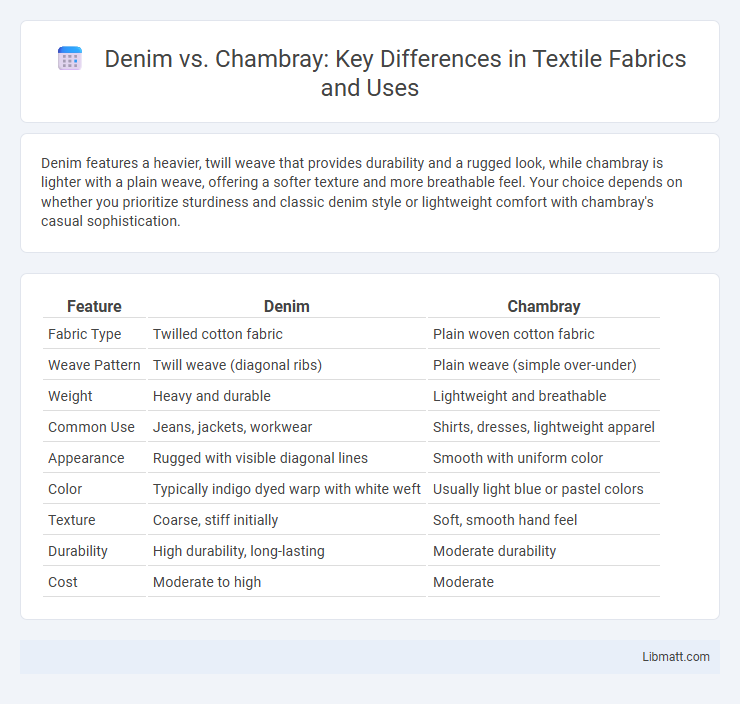Denim features a heavier, twill weave that provides durability and a rugged look, while chambray is lighter with a plain weave, offering a softer texture and more breathable feel. Your choice depends on whether you prioritize sturdiness and classic denim style or lightweight comfort with chambray's casual sophistication.
Table of Comparison
| Feature | Denim | Chambray |
|---|---|---|
| Fabric Type | Twilled cotton fabric | Plain woven cotton fabric |
| Weave Pattern | Twill weave (diagonal ribs) | Plain weave (simple over-under) |
| Weight | Heavy and durable | Lightweight and breathable |
| Common Use | Jeans, jackets, workwear | Shirts, dresses, lightweight apparel |
| Appearance | Rugged with visible diagonal lines | Smooth with uniform color |
| Color | Typically indigo dyed warp with white weft | Usually light blue or pastel colors |
| Texture | Coarse, stiff initially | Soft, smooth hand feel |
| Durability | High durability, long-lasting | Moderate durability |
| Cost | Moderate to high | Moderate |
Introduction to Denim and Chambray
Denim is a durable, twill-weave fabric typically made from cotton, known for its distinct diagonal ribbing and heavy weight, commonly used in jeans and jackets. Chambray features a lighter, plain weave with a softer texture and smooth finish, often used in shirts and casual wear. Understanding these fabric differences helps you choose the right material for style and comfort in your wardrobe.
Origin and History
Denim originated in the French city of Nimes during the 17th century, known as "serge de Nimes," and gained widespread popularity in the United States as durable workwear in the late 1800s. Chambray dates back to the 18th century and was originally woven in Cambrai, France, featuring a lighter, plain weave fabric with colored warp threads and white weft threads. While denim uses a twill weave creating its characteristic diagonal ribbing, chambray's plain weave results in a softer, lighter texture, reflecting their distinct historical applications and manufacturing techniques.
Fabric Construction Differences
Denim is woven using a twill weave, characterized by diagonal ribbing that provides durability and a heavier feel, making it ideal for jeans. Chambray, on the other hand, is constructed with a plain weave, resulting in a lighter, smoother fabric with a more breathable texture suitable for shirts. The differing weave patterns directly impact their weight, texture, and typical applications in fashion.
Appearance and Texture
Denim features a rugged, twill weave with a coarse texture and a distinct diagonal rib pattern, giving it a heavier and more durable appearance. Chambray showcases a plain weave with a smoother, lighter texture and a subtle sheen, often resembling denim in color but feeling softer and more breathable. Your choice between denim and chambray will depend on whether you prefer a sturdy, textured fabric or a lighter, smoother material.
Durability and Strength
Denim is made from a twill weave that gives it exceptional durability and strength, making it ideal for heavy-duty use and long-lasting wear. Chambray, woven with a plain weave, is lighter and less robust, offering comfort but less resistance to abrasion and tearing. Your choice depends on whether you need rugged durability with denim's toughness or the breathability and softness found in chambray.
Comfort and Breathability
Denim, made from tightly woven cotton twill, offers durability but tends to be heavier and less breathable, making it less comfortable in warm weather. Chambray, woven with a plain weave using lighter cotton yarns, provides superior breathability and a softer texture, enhancing comfort during hot and humid conditions. The lightweight and airy structure of chambray allows for better moisture wicking and ventilation compared to the dense, rugged denim fabric.
Versatility in Fashion
Denim offers unparalleled versatility in fashion, seamlessly transitioning from casual to semi-formal styles with its durable twill weave and thicker texture. Chambray's lightweight, plain weave fabric provides a breathable option ideal for summer wear while maintaining a polished appearance. Both materials excel in layering, with denim lending ruggedness and chambray contributing a softer, more refined aesthetic for diverse outfit combinations.
Care and Maintenance
Denim requires cold water washing and air drying to preserve its color and texture, while avoiding bleach to prevent fabric damage. Chambray benefits from gentle machine washing with mild detergent and low heat drying to maintain its lightweight softness. Both fabrics need minimal ironing and should be stored in cool, dry conditions to extend garment longevity.
Styling Tips: When to Wear Denim vs Chambray
Denim offers a rugged, durable look ideal for casual outings and cooler weather, pairing well with boots and heavier accessories. Chambray's lighter, breathable fabric suits warmer climates and smart-casual settings, complementing chinos or tailored shorts for a polished yet relaxed style. Your wardrobe benefits from choosing denim for a bold, structured statement and chambray for versatile, comfortable layering.
Conclusion: Choosing the Right Fabric
Denim offers durability and a heavier texture ideal for sturdy, long-lasting garments, while chambray provides a lighter, breathable fabric perfect for casual, warm-weather wear. Selecting the right fabric depends on the intended use, with denim suited for rugged clothing like jeans and chambray favored for shirts and airy summer outfits. Both fabrics feature similar weaving techniques but differ in weight and finish, influencing comfort and style preferences.
Denim vs Chambray Infographic

 libmatt.com
libmatt.com